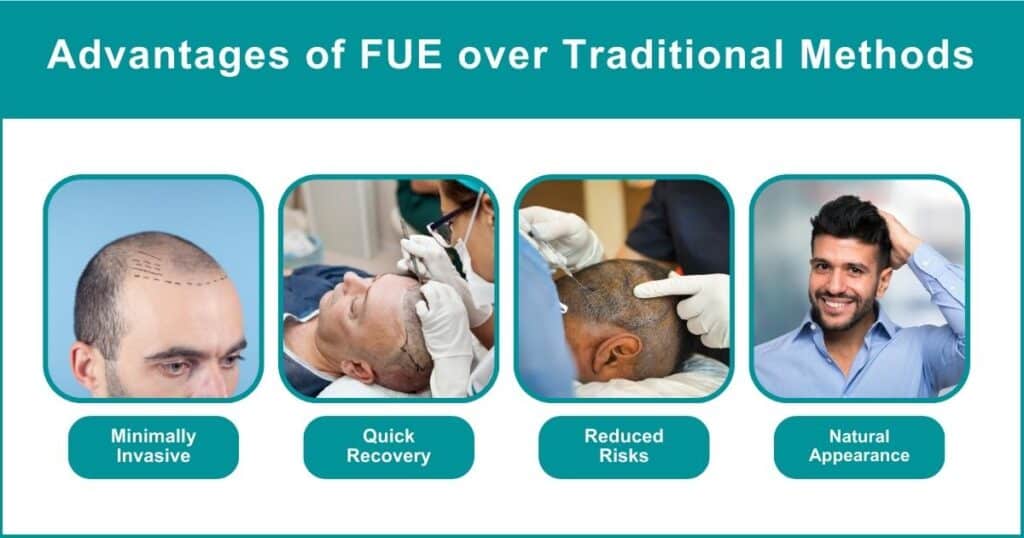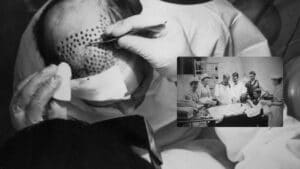Are you looking for a permanent solution to hair loss? FUE, or follicular unit extraction, is an advanced and minimally invasive hair restoration procedure that offers many benefits over traditional methods. Unlike other procedures which have had poor results in the past, FUE provides natural-looking results. One of the main benefits of FUE is the minimal scarring and no linear incision scar.
Learn more about the benefits of FUE as well as its process and potential risks associated with it.
Table of Contents:
- What is FUE?
- Benefits of FUE Over Other Hair Restoration Options
- The Process of an FUE Hair Transplant Procedure
- Potential Risks and Complications Associated with the FUE Procedure
- Conclusion
What is a Follicular Unit Transplant?
Follicular Unit Extraction (FUE) is a state-of-the-art hair restoration technique used to treat baldness and thinning hair. This method involves meticulous handling of individual hair follicles, providing an efficient and less intrusive solution than older techniques.
Procedure Overview:
- Extraction: Individual follicles are extracted from the donor area of the scalp where thick hair is still present.
- Transplantation: The extracted follicles are transplanted into areas experiencing thinning or baldness.
- Recovery: Generally, full recovery is seen within a week, notably faster than alternative methods like FUT strip harvesting.
Results: As only healthy hairs are selected for transplantation, the results look natural and aesthetically pleasing.
Advantages of FUE over Traditional Methods:
The FUE method has several significant advantages over traditional methods, such as strip harvesting (FUT) and scalp micro pigmentation, including:
- Minimally Invasive: It uses small punches to remove individual hairs, leaving no linear scarring.
- Fast Recovery Time: Usually just one week, compared to two weeks with FUT.
- Fewer Risks: No large incisions are made, reducing risks and healing time.
- Natural-Looking Results: Careful selection of healthy hairs ensures a more natural appearance.
| Comparison between FUE and Traditional Methods | FUE | Traditional Methods (FUT) |
| Invasiveness | Minimally invasive | More invasive |
| Recovery Time | About one week | About two to three weeks |
| Scarring | No visible scars | Linear scarring |
| Results | Natural-looking | Can vary |
Benefits of FUE Over Other Hair Restoration Options
In comparison to
When considering hair restoration options, it’s essential to evaluate various methods and techniques to find the one best suited to individual needs and expectations. Three popular choices are Follicular Unit Extraction (FUE), Scalp Micropigmentation (SMP), and Platelet Rich Plasma Therapy (PRP), each with distinct advantages and limitations. To provide a clear understanding of these options, the table below offers a comparative overview, highlighting essential aspects such as procedure type, duration, scarring, and long-term efficacy. Making an informed decision can lead to more satisfying results and improved confidence and well-being
Comparison of Hair Restoration Options: FUE, SMP, and PRP
| Feature/Method | FUE (Follicular Unit Extraction) | SMP (Scalp Micropigmentation) | PRP (Platelet Rich Plasma) |
| Procedure Type | Surgical | Non-surgical (Tattooing) | Non-surgical (Injections) |
| Duration | One day | Multiple sessions | Multiple sessions |
| Scarring | Minimal | None | None |
| Pain and Discomfort | Less | Varies | Varies |
| Recovery Time | Shorter | Immediate | Immediate |
| Long-term Efficacy | High | Temporary | Still under research |
| Risks and Drawbacks | Minimal | Requires recurrent treatments | Risk of infection |
The Process of an FUE Hair Transplant Procedure
Pre-Procedure Preparation and Planning:
Before undergoing an FUE hair transplant procedure, a patient should prepare for the surgery by discussing their medical history with their doctor. This includes any medications they are taking or allergies they may have. The doctor will also assess the patient’s scalp to determine if there is enough donor hair available for the procedure. At this stage, it is essential to inquire about any potential dangers linked with the procedure and adhere to all pre-operative instructions given by your doctor.
The Extraction Process and Graft Placement:
During an FUE hair transplant, individual follicular units (FUs) are extracted from a donor area of healthy hairs on the back or sides of the head. We use a specialized instrument known as a micro punch device. Next, we transplant these grafts into tiny incisions made in balding areas of the scalp using tweezers or forceps. After each graft’s placement in the scalp, we cover it with a special solution to protect it until healing occurs over several days post-procedure.
Following Your Procedure
Immediately after an FUE hair transplant procedure, patients can expect some swelling around their forehead and eyes that should subside within two weeks post-surgery. Patients must avoid strenuous activity during this period as well as direct sun exposure to prevent further damage to newly transplanted follicles while they heal properly over time. It typically takes up to three months before new hairs begin growing in transplanted areas. however, full results may take up to one year depending on the individual’s healing rate.
Potential patients of FUE hair transplant should be conscious of the associated risks. However, it is a reliable and successful method to regain lost or diminishing hair permanently. With proper preparation and post-procedure care, most people can experience successful results from an FUE hair transplant.
Potential Risks and Complications Associated with the FUE Procedure
When looking at a hair transplant, it is imperative to be aware of the potential dangers and complications related to FUE (Follicular Unit Extraction). Infection risk factors and prevention strategies for the procedure site, scarring, bleeding, swelling after the procedure, and long-term effects on hair growth are all things that should be taken into account before undergoing any type of hair restoration.
Infection Risk Factors:
The most common infection risk factor associated with FUE procedures is improper post-operative care. To minimize this risk, follow your doctor’s instructions closely while caring for the area your surgeon placed the grafts. It is also essential to keep the scalp clean during recovery by washing it regularly with mild shampoo or soap. Additionally, antibiotics may be prescribed in order to reduce infection rates following surgery.
Scarring:
Scarring can occur as a result of an FUE procedure due to damage caused by extraction tools used during harvesting or from the trauma inflicted while placing grafts in recipient sites. This can lead to permanent scarring which could affect future hair growth if not properly managed prior to surgery through pre-treatment measures such as laser therapy or topical treatments like minoxidil.
In some cases, however, minor scarring can be camouflaged using special techniques such as scalp micropigmentation (SMP). This involves tattooing pigment onto bald areas in order to replicate natural-looking hairs without actually implanting them into the skin.
Bleeding & Swelling:
Bleeding and swelling are normal side effects following any kind of invasive medical treatment. They typically subside within two weeks after an FUE transplant surgery. However, if excessive bleeding persists for more than 24 hours then you should seek medical attention immediately since this could indicate a more serious underlying issue that needs further investigation from your doctor or surgeon.
Furthermore, applying ice packs directly over donor sites helps reduce inflammation around these areas too. Make sure you do this several times throughout each day until healing fully occurrs. However, don’t leave them on longer than 15 minutes at one time.
Consequently, anyone considering hair transplantation must comprehend precisely what they must do pre and post-surgery. This helps to attain the most favorable results. Failing to adhere strictly enough to their doctor’s advice regarding proper post-operative care protocols can result in thinning or loss of transplanted hairs months after the initial operation took place.
Now You Understand the Benefits of FUE Hair Transplants
In conclusion, the FUE (Follicular Unit Extraction) process is superior for hair restoration. It offers a minimally invasive approach and a shorter recovery time than traditional methods like strip harvesting and scalp reduction surgery.
With FUE, you can anticipate natural-looking results, minimal scarring, and no visible donor site marks. FUE’s positive outcomes and lasting effects have made it a preferred option for those aiming to regain their youthful appearance and self-confidence.
If you’re ready to embark on a journey to restore your hair, it’s time to consider the unique benefits of an FUE Hair Transplant. Our expert team is here to assist you in determining if this is FUE hair transplant right and the ideal solution tailored to your specific needs and aspirations.
Take the First Step Towards a New You – Schedule an Appointment Today! Your beautiful transformation is just a click away.
Best Hair Transplant
1970 S. Prospect Ave., Suite 2
Redondo Beach, CA 90277
(213) 403-0455
https://www.google.com/maps?cid=9280610872186794918
To ensure your ease of mind, you can view our customer recommendations HERE. Furthermore, you can also see our Google reviews and Yelp reviews. We can’t wait to help you start restoring your lost hair.



